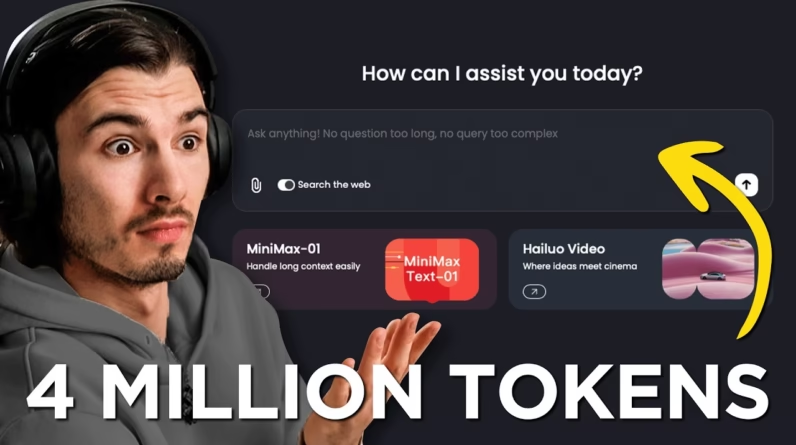
In recent years, powerful no-code app development platforms have opened doors for individuals who may not have traditional programming skills. By utilizing these platforms, you can effortlessly create applications tailored to your needs, empowering you to bring your ideas to life. This article explores several exciting developments, including the introduction of Dolphin 3.0 and announcements from CES 2025, highlighting tools and innovations designed to make powerful AI accessible to everyone.
Get ready to discover how these advancements in no-code technologies can streamline your creative process. From the features of Dolphin 3.0 to the potential of Microsoft’s latest AI models, you’ll find resources that enable you to harness cutting-edge tools without any costs. As you explore these technologies, you’ll see just how easy it is to harness the potential of AI and create applications that can enhance your life and work.

Table of Contents
Understanding No-Code App Development
Definition of No-Code Platforms
No-code platforms are tools designed to allow individuals without extensive programming knowledge to create applications and software. By providing user-friendly graphical interfaces and drag-and-drop functionalities, these platforms empower you to build functional applications simply by selecting pre-made components and configuring them to your liking. This means, you can focus more on the idea and design rather than getting caught up in complex coding languages.
The Rise of No-Code as a Movement
In recent years, there has been a noticeable shift in the tech landscape toward no-code development. This movement has gained momentum due to the increasing accessibility of technology and the urgent need for businesses to innovate quickly. No longer is coding an exclusive domain of trained developers—many organizations recognize that empowering all employees to participate in digital innovation can lead to more creative solutions and faster product releases. This democratization of development encourages you to explore your creativity without the typical barriers associated with software development.
Benefits of No-Code Development for Non-Developers
The advantages of no-code platforms are particularly pronounced for non-developers like yourself. You can rapidly prototype your ideas and bring them to life without needing to hire a developer or learn programming. This not only saves time but also reduces costs. Furthermore, no-code platforms enable you to iterate on your ideas quickly, making adjustments and updates as you gather user feedback. Overall, this means you can be more agile in responding to market demands or user needs.
Top No-Code Platforms of 2024
Overview of Leading No-Code Platforms
As we step into 2024, several no-code platforms are leading the way in the market. Webflow, Bubble, Adalo, and Glide are among the most popular choices, each catering to different needs and user demographics. They offer a range of features from website design to mobile application development, making them well-suited for various projects. Regardless of your specific goals, there’s likely a platform that aligns with your vision.
Feature Comparisons of Webflow, Bubble, Adalo, and Glide
When comparing leading no-code platforms, you will notice distinct features and capabilities.
- Webflow specializes in web design and development, allowing for intricate design customizations and integration with e-commerce features.
- Bubble is well-known for its focus on creating more complex applications that require a backend, making it ideal for those looking to establish a robust web application.
- Adalo excels at mobile app creation, making the process seamless with quick deployment options.
- Glide takes a unique approach by transforming Google Sheets into fully functional apps, appealing to users who want to build lightweight applications quickly.
By determining what features matter most for your project, you can better choose which platform fits your needs.
Target User Demographics and Project Suitability
Each no-code platform appeals to different demographics of users. Webflow is popular among designers and marketers who prioritize aesthetics; Bubble attracts entrepreneurs and startups ready to develop scalable web applications; Adalo is favored by those aiming for mobile-first solutions; and Glide caters to educators and non-profits needing efficient, straightforward app solutions. Identifying your target audience and the specific type of project can help you select the right platform.
Key Features of Popular No-Code Platforms
Customization Options Across Different Platforms
One of the essential aspects of no-code platforms is the level of customization they allow. In Webflow, you can customize layout elements extensively and add animations, which is beneficial for design-heavy projects. Bubble offers a robust workflow builder that allows you to create various functionalities with visual objects. Adalo and Glide allow you to establish simple interactions and layout adjustments, making it easy to create a functional application quickly. Thus, you can choose the platform that provides the right customization options to suit your project’s demands.
Integration Capabilities with Other Tools
Integration capabilities are crucial for a smooth development experience. Most no-code platforms offer various integrations with popular tools like Zapier, Google APIs, and payment gateways. This allows you to extend the functionality of your application without having to write code. For example, you might want to connect your app to external databases or marketing tools. The platform you choose should offer reliable integration options to ensure your app can grow and interact with other tools you rely on.
User Support and Documentation Availability
Support and documentation are vital resources for users new to no-code development. The more comprehensive and accessible these resources are, the easier your development process will be. Popular platforms like Bubble and Webflow provide extensive tutorials, community forums, and customer support, allowing you to find help when you need it. It’s crucial to check what kind of support each platform offers and how active their community is, as these can be significant factors in successfully launching your app.
Use Cases for No-Code Development
Building Small Business Applications
No-code platforms are ideal for small business owners who need tailored applications without the extensive resources of a large tech team. You can create inventory management systems, customer relationship management (CRM) tools, or appointment scheduling apps, all tailored to fit your business procedures. This allows you to increase efficiency and address challenges your business might face without incurring hefty development costs.
Creating Landing Pages and Marketing Sites
Creating compelling landing pages is essential for marketing campaigns, and no-code platforms excel here. With intuitive design tools, you can build beautiful, conversion-optimized landing pages without worries about coding. Platforms like Webflow can help you design visually stunning sites as quickly as you can think through your campaign’s messaging.
Automating Workflows and Internal Processes
Automation can significantly reduce tedious tasks in your daily operations. No-code solutions can allow you to create internal tools for automating workflows such as data collection or reporting. Through platforms that integrate with your existing tools, you can streamline processes and enhance productivity. For example, you might automate onboarding processes, track team performance, or even manage task assignments, all while minimizing human error.
How to Choose the Right No-Code Platform for Your Project
Assessing Project Type and Goals
When deciding on a no-code platform, it’s crucial to assess your project type and objectives carefully. Are you building a simple landing page or a complex web application? Understanding your project’s scope and specific goals will help you narrow down your options. Each platform has strengths, so make sure to align those with your needs.
Budget Considerations in Choosing a Platform
Your budget plays a significant role in selecting a no-code platform. While many platforms have free tiers, advanced features typically come with monthly fees. Carefully review each platform’s pricing structure to determine which options align best with your financial capacity. Remember that it’s often worth investing in a platform that meets your needs thoroughly initially rather than switching later.
Evaluating Ease of Use and Learning Curve
While no-code platforms aim to be user-friendly, they still come with some learning curves. Assess how intuitive the platform is compared to your comfort level with technology. Platforms like Glide and Adalo are generally considered easier for beginners, while Bubble might have a steeper learning curve due to its complexity. Test out trials and explore tutorials to gauge what feels manageable before making a decision.
Step-by-Step Guide to Getting Started
Creating Your First App with No-Code Tools
Starting your first app can be a rewarding experience. First, choose your no-code platform based on the earlier criteria—your project type, goals, and budget. Next, outline your app’s primary features and layout. Begin by utilizing templates if available and customize them according to your vision. Finally, conduct tests and solicit feedback as you iterate on your app until it meets your standards.
Design Best Practices for Non-Developers
As you create your app, keep design principles in mind. Use clear navigation, maintain a consistent color palette, and prioritize readability. Don’t overcrowd your interface; simplicity often leads to a better user experience. Tools within the no-code platforms can guide you on design best practices, so take advantage of available resources to enhance the look and functionality of your application.
Common Pitfalls to Avoid During Development
Many first-time no-code developers encounter common pitfalls. One major issue is feature creep; it’s easy to want to add too many features, which can complicate your app. Stay focused on your primary objectives and refine the project gradually. Additionally, neglecting user feedback can lead to missed opportunities for improvement—engage your audience early and often.
Real-World Success Stories
Case Studies of Businesses Using No-Code Platforms
Many businesses have thrived using no-code platforms. For example, a local bakery utilized Bubble to develop a custom ordering system that allowed for easy menu updates and customer feedback, enhancing the customer experience and streamlining their operations. Another example is an education startup that built an engaging platform on Webflow, which attracted increased users and engagement thanks to its visually appealing design and functionality.
Quantitative Benefits Realized by Users
Businesses leveraging no-code solutions have reported increased productivity and cost savings. For instance, companies often cite reductions in development time—sometimes cutting weeks off their timelines—to launch functionalities crucial to their operations. Ultimately, the financial benefits and quicker time-to-market can significantly impact a business’s bottom line.
Lessons Learned from Successful No-Code Projects
Successful no-code projects teach that continual iteration and user feedback are pivotal for success. These success stories reveal the benefits of being open to change and improving your development process. Being flexible and responsive to your audience helps ensure that your application remains relevant and useful as user needs change.
Limitations of No-Code Platforms
Understanding the Constraints of No-Code Solutions
While no-code platforms are powerful, they also come with limits. There may be restrictions on the complexity of applications you can create, especially if you want advanced data processing or custom backend development. Understanding these limitations beforehand helps you set realistic expectations for your project.
When to Consider Professional Development
If your project scale or requirements exceed what no-code platforms offer, it may be time to consider hiring a developer. Projects requiring highly specialized functionalities or significant backend processing often benefit from custom coding. There’s no shame in recognizing when a project requires a level of expertise beyond what a no-code tool can deliver.
Scalability Issues with No-Code Applications
Another potential limitation is scalability. As your application gains more users or demands more complex functionalities, you might find performance constraints. Some no-code platforms may struggle to accommodate rapid growth, so it’s crucial to evaluate whether the platform can handle future needs. This consideration is particularly important if you’re planning a long-term project.
Future Trends in No-Code Development
Emerging Technologies Influencing No-Code Platforms
The future of no-code platforms looks bright as emerging technologies enhance their capabilities. Integrations with AI, machine learning, and automation tools are becoming more prevalent. These innovations help to create smarter applications and reduce manual processes, making development even more straightforward for you as a non-developer.
Predictions for the Next Generation of No-Code Tools
Looking ahead, we can expect even more specialized no-code tools catering to specific industries or project types. The next generation of no-code platforms may leverage user feedback more dynamically, allowing for instant updates and user-customizable features that enhance engagement and capabilities.
The Potential of AI Integration in No-Code Development
AI integration into no-code platforms has the potential to revolutionize development. By automating repetitive tasks and suggesting design improvements or features based on user behavior, these platforms will likely evolve to make development even more efficient. This would enable you to create even more sophisticated applications without needing extensive technical skills.
Conclusion
Recap of the Empowerment Offered by No-Code Platforms
In summary, no-code platforms empower individuals like you by removing the traditional barriers associated with software development. This empowerment allows you to create, innovate, and solve problems with minimal resources, opening a new world of possibilities.
The Growing Importance of No-Code in Today’s Tech Landscape
As businesses seek agility and efficiency in a rapidly changing marketplace, the significance of no-code solutions will continue to grow. No-code platforms enable you to respond quickly to trends, user needs, and business demands, ultimately contributing to more dynamic and responsive organizations.
Encouragement for Non-Developers to Explore No-Code Solutions
If you’ve ever felt the urge to create an app or solve a problem through technology but hesitated due to a lack of coding skills, take the plunge! Dive into the world of no-code development and explore how these tools can bring your ideas to life. With patience and practice, you’ll find that building applications is more achievable than you ever thought possible.







